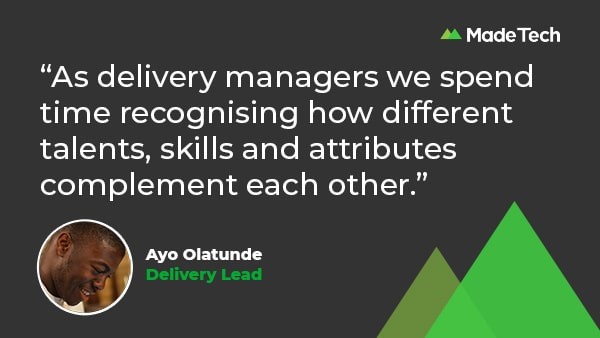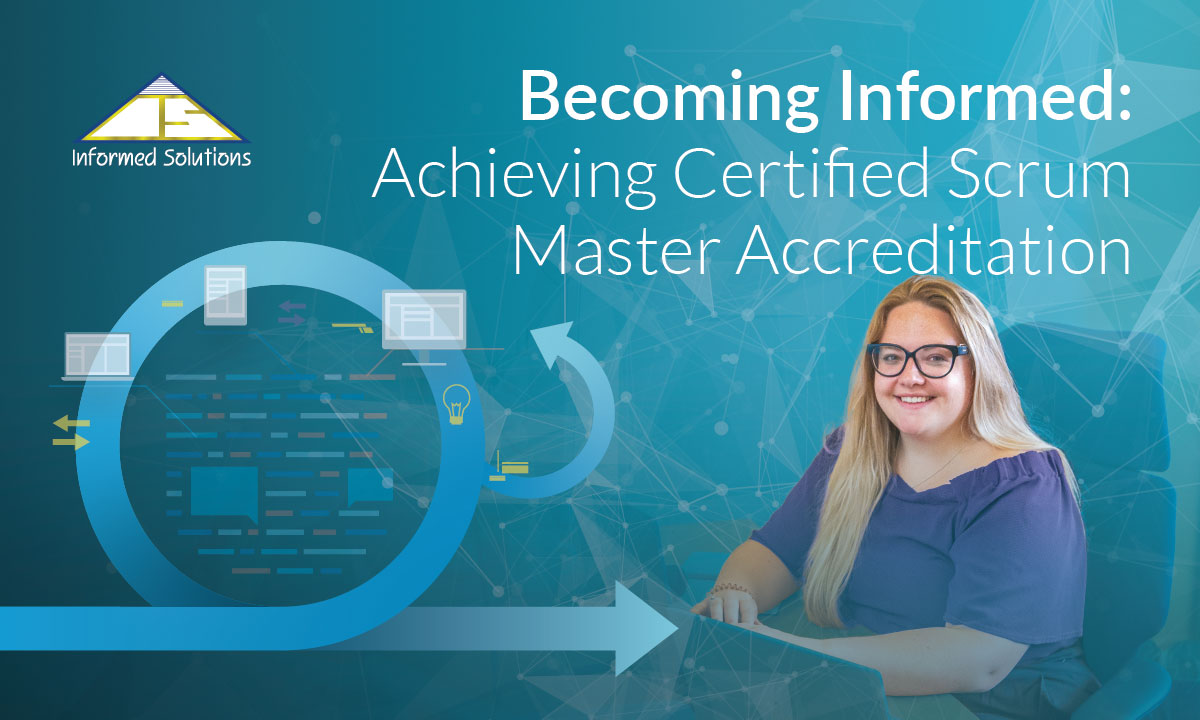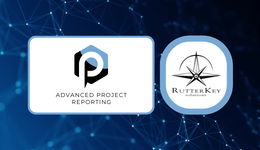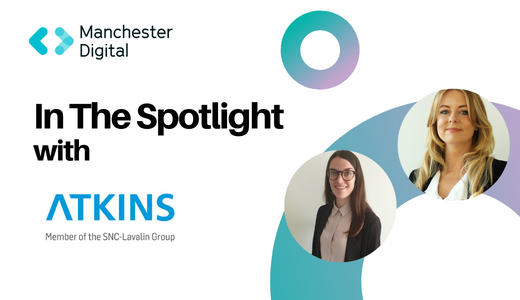
Before I worked at Made Tech I worked as a delivery lead. Back then, I worked closely with a business analyst who went on to become a delivery manager. After a few weeks in their new role they messaged me; “I never realised just how much you were doing!” One of the frustrating parts of a delivery manager’s role is that while we know how much value we’re adding, it’s not always obvious or visible – even to the people we collaborate with regularly.
Clients sometimes feel they don’t need a delivery manager. That is, until they’ve had one and they leave. The good old saying of “you never know what you’ve got ‘till it’s gone” comes to mind. Teams that haven’t worked with a delivery manager before might struggle to see our value. The work we do is often seen by few, but felt by many.
Making sure we drive delivery while empowering the team is a tricky balance to explain. In this post I’ll shed some light on just some of the tasks your friendly delivery manager does.
Building a dream team
Building a high-performance team might sound easy, right? Bringing a bunch of highly skilled people together to work toward one common goal. They’ll seamlessly work together to solve problems and showcase excellent levels of communication and collaboration while delivering consistent results. But it’s not quite that easy.
While high-performance teams are valued by investors and tech giants, creating this type of unified team is quite the task. Especially when our working environments are constantly changing and adapting to new technologies and ways of working.
Building (and nurturing) successful teams means recognising people’s individual strengths and grouping those who’ll collaborate well together. As delivery managers we spend time recognising how different talents, skills and attributes complement each other. A wonderful mixture of abilities helps create a force that can overcome challenges and meet goals. And although this can seem like a daunting challenge, the pay-offs far outweigh the effort.
Balancing stakeholders
A senior Aerospace project manager once said; “If you can’t take the time to get to know who your stakeholders are and learn what they want, then what are you doing in this job?”
Our role as delivery managers (as the name suggests) means we deliver the work that stakeholders want us to. Now, if you don’t take this part seriously, you’re setting yourself up to fail because ultimately the stakeholders are your final judges.
At the start of the project the main things we need to tease out of our stakeholders are what we call the golden triangle. In delivery terms, this is the high-level scope requirements and quality, time and cost constraints. But we also need to understand all other high-level wants, needs and restrictions that could affect planning.
A specific part of this is truly understanding their vision for the work, how they see it panning out. It’s worth noting here that it’s not unusual to sometimes disagree with their opinions —and that’s okay. But first, you need to understand them.
One of the most important tasks we do as delivery managers is to clearly define and document project objectives. Getting these things in writing early and signed off by stakeholders means we formally know what the delivery is about. Not doing this leaves the door wide open for misunderstandings and mismatched expectations.
Facilitation’s ‘new look’
Facilitation is the act of engaging people in creating, discovering and collaborating. Opposed to presentations where we deliver content to an audience, facilitation usually involves a “guide on the side”. As delivery managers we take on this role of guide – we ask questions, moderate discussions, introduce activities and help participants learn.
Facilitation has far outgrown its traditional image. It’s no longer about someone standing at the front of the room guiding a group of people through processes. It’s also no longer just about decision making, conflict resolution or team building. Facilitation has a new look.
The skills we now use for facilitation are those we also need in our everyday lives. Such as communication styles that help us be more agile in conversations, flowing from different topics and engaging people. In today’s divisive world, we’re becoming more aware of engaging in ways that open the conversation, rather than close it down.
Effective facilitation means recognising different perspectives and skills to create an inclusive environment where everyone can contribute. Discussion is a powerful mechanism for active learning. A well-facilitated discussion allows everyone to explore new ideas while recognising and valuing the contribution of others.
Making decisions at the right time
Decision-making can sometimes feel like a magically mystical process, but it helps to think of it as a science. If your own team struggles with group decision-making, take comfort in the fact that you’re not alone.
Not every decision requires in-depth consideration. According to Parkinson’s law of triviality, organisations disproportionately spend time on minor decisions, instead of focusing on the significant ones. One undervalued skill of a delivery manager is encouraging which choices to deliberate over as a group, versus which ones to make quickly. Needless to say this will free up your team’s time and resources.
Reducing friction
Friction in projects is not unusual, but it can be damaging when it causes an issue with productivity. For example, there can occasionally be friction in the software supply chain. There’s a lot of work involved in creating applications that can move across environments, involving a lot of different people. It takes time and skill to tweak and adjust all the dependencies, configurations and libraries that go into a typical application. And any friction can affect the huge amount of productivity needed to get this all done. But it’s not only in IT software. Interpersonal friction can also be a cause. I’m sure everyone reading this has experienced some kind of workplace politics throughout their careers.
It’s important to remember that inside a company, we’re all working toward the same goal – to deliver value to our clients. Delivery managers encourage safe feedback loops, clear objectives and help everyone check egos at the door to reduce friction. All of these create the conditions for efficient operations which increases productivity and the best possible outcomes.
Aligning the team
Paisley Laurenzio tells us that it’s easy for people in different disciplines to unconsciously work in silos. Different points of view can mean one team is working toward different goals – not ideal. I’ve definitely experienced this on projects in the past, resulting in frustration and a lot of wasted time.
In a team, designers are often the voice of the user and they advocate for the best experience possible. Product management needs to make sure the business and vision of the project are communicated and priorities are correct. And developers bring a technical perspective on how best to build the product.
So how do we bring all these wonderfully skilled people together? Supported by their delivery manager, the team can work together to identify the problem and contribute to a solution. Collaboration is key. A cohesive team is a confident team. Truly working together helps us all achieve the same goal, which can save a lot of time spent aligning and re-aligning.
The art of delivery
I’m sure any delivery manager reading this will agree it’s not an exhaustive list of our responsibilities. But it sheds just a light on some of the things we have to consider on a daily basis.
Delivery is not just about managing a backlog or creating a roadmap. It’s so much more than that, it’s an art that can add essential value to a team. And a reminder to my fellow delivery managers. You may not always be able to pinpoint every task where you’re making an impact, but remember that there’s great value in the invisible work you’re doing every day.
If you want to learn more about the work we do here at Made Tech why not subscribe to our Made Tech Insights newsletter to get new blog posts straight to your inbox?








